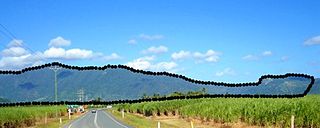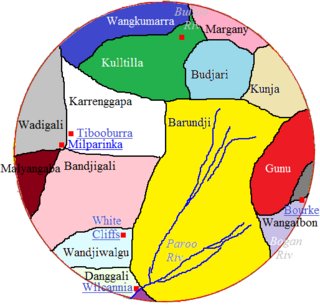The Murrinh-Patha, or Murinbata, are an Aboriginal Australian people of the Northern Territory.
The Murrinh-Patha, or Murinbata, are an Aboriginal Australian people of the Northern Territory.
Murrinh-Patha is spoken by about 2500 people, and serves as a lingua franca for several other ethnic groups, such as the Mati Ke or Maridjabin, whose languages are extinct or threatened. [1] It is not clearly related to other languages.
The Murrinh-Patha's traditional lands extended some 800 square miles (2,100 km2) inland from Wadeye, formerly known as Port Keats reaching eastwards the Macadam Range. Its southern limits lay at Keyling Inlet and the mouth of the Kemoi / Fitzmaurice River (native name Kemol). They expanded southwards in historical times to take over the territory of the Muringura, who were then absorbed into the tribe. [2]
The Murrinh-Patha consisted of 8 groups.
The Murrinh-Patha conducted a bullroarer ceremony, known secretly as Karwadi, and publicly as the Punj. This was analysed by W. E. H. Stanner in terms of a pattern he discerned underlying the more general rite of sacrifice in other cultures, consisting of (a) something of value consecrated to a spiritual being, and whose aim lies beyond the common ends of life; (b) the object of sacrifice undergoes transformation; (c) The object of sacrifice, whose nature has thereby been transformed, is restored to those who made the offering; and (d) and then shared by the community, allowing their loss of the earlier state to be offset by a gain. [3] In the general context of aboriginal religion, such initiations instill the idea that in the Dreamtime, extraordinary events once took place which set the fundamental pattern of man's life in his given environment, and the living must commemorate and keep actively in touch with the symbolic truths and paths outlined illo tempore. Broadly speaking he writes that:
The Karwadi ceremony may be described as a liturgical transaction, within a totemic idiom of symbolism, between men and a spiritual being on whom they conceive themselves to be dependent. [4]
It took from one to two months to complete, and was participated in by members from both patrimoiety groups in neighbouring clans. The young men who are the subject of the Karwadi rite of initiation are candidates who have already been circumcised, but require this last stage of initiation because they are still regarded as refractory to the discipline of full maturity. [5] Karwadi is a secret name for the Mother of All, alternatively known as The Old Woman and the core of the ceremony consists in revealing to them her emblem, the ŋawuru (bullroarer). [6]
After consultation the young men, without compulsion, are taken to a ŋudanu (ceremonial ground) where the fully initiated men (kadu punj) circle them and chant a long refrain which concludes at sundown with the exclamatory of the Mother of All's hidden name, invoked with the cry Karwadi yoi!. All then return to the main camp, with the youths forbidden to speak to both patri- and matrikin, and required to eat alone, as their needs are attended to by adult men.
With the first sighting of the Morning star the initiands are taken back to the ŋudanu, and from that moment they are neither addressed, nor even seen, by anyone who does not belong to the group of adult men overseeing the performance to the end. As they take up the singing once more, men indulge in the comic antics of tjirmumuk, a jostling horseplay between moiety members, including attempts to grab each other's genitals, interleaved with obscene remarks that would normally never be tolerated. [5]

Australian Aboriginal religion and mythology is the sacred spirituality represented in the stories performed by Aboriginal Australians within each of the language groups across Australia in their ceremonies. Aboriginal spirituality includes the Dreamtime, songlines, and Aboriginal oral literature.

The Bidawal were an Australian Aboriginal tribe of Gippsland, Victoria. According to Alfred William Howitt, the Bidawal were composed of "refugees from tribes".
Murrinh-patha, called Garama by the Jaminjung, is an Australian Aboriginal language spoken by over 2,000 people, most of whom live in Wadeye in the Northern Territory, where it is the dominant language of the community. It is spoken by the Murrinh-Patha people, as well as several other peoples whose languages are extinct or nearly so, including the Mati Ke and Marri-Djabin. It is believed to be the most widely spoken Australian Aboriginal language not belonging to the Pama-Nyungan language family.

The Ngarigo people are Aboriginal Australian people of southeast New South Wales, whose traditional lands also extend around the present border with Victoria. They are named for their language, Ngarigo, which in the 19th century was said to be spoken by the Nyamudy people.

The Muthi Muthi people are an indigenous Australian people whose traditional lands are located in the Northern Riverina and Far West regions of New South Wales.
The Mati Ke, also known as the Magatige, are an Aboriginal Australian people, whose traditional lands are located in the Wadeye area in the Northern Territory. Their language is in danger of extinction, but there is a language revival project under way to preserve it.
The Marrithiyal, also written Marrithiel, are an Aboriginal Australian people whose traditional territory lay 100 to 130 miles south of Darwin from Litchfield National Park and extend to the Daly River in the Northern Territory. They are also known as the Berringen people to represent their affiliation and deep connections across the neighbouring South Western Daly region.
The Ngan'gimerri, also spelt Nangiomeri, Nanggumiri, and other variants, are an Aboriginal Australian people of the Daly River area in the Northern Territory.
The Erawirung people, also known as Yirau, Juju and other names, were an Aboriginal Australian people whose traditional territory was located in what is today the Riverland of South Australia. They consisted of sub-groups or clans, including Jeraruk, Rankbirit and Wilu, and have been referred to as Meru people, which was a larger grouping which could also include the Ngawait and Ngaiawang peoples.
The Maridjabin (Maridan) or Marrisjabin, were an indigenous Australian people of the Northern Territory.
The Marijedi (Mariyedi) are an indigenous Australian people of the Northern Territory.

The Bardi people, also spelt Baada or Baardi and other variations, are an Aboriginal Australian people, living north of Broome and inhabiting parts of the Dampier Peninsula in the Kimberley region of Western Australia. They are ethnically close to the Jawi people, and several organisations refer to the Bardi Jawi grouping, such as the Bardi Jawi Niimidiman Aboriginal Corporation Registered Native Title Body and the Bardi Jawi Rangers.

The Karenggapa are an Aboriginal Australian people of New South Wales.
The Pilatapa were an Indigenous people of South Australia, now extinct.
The Mingin, also known as the Mingginda, are an Aboriginal Australian people of the state of Queensland, who lived in the Gulf Country east of Moonlight Creek and the Yukulta / Ganggalidda people in the southern Gulf of Carpentaria.
The Weraerai (Wirraayaraay) were an indigenous Australian people of the state of New South Wales. They are to be distinguished from the Ualarai.
The Ngawait, also spelt Ngawadj and other variations, and also known as Eritark and other names, were an Aboriginal Australian people of the mid-Riverland region, spanning the Murray River in South Australia. They have sometimes been referred to as part of the Meru people, a larger grouping which could also include the Ngaiawang and Erawirung peoples. There were at least two clans or sub-groups of the Ngawait people, the Barmerara Meru and Muljulpero maru.
The Yunggor were an Aboriginal Australian people of the Northern Territory.
The Muringura, or Murrinh-Kura, were an indigenous Australian people of the Northern Territory.
The Norweilemil were an indigenous Australian people of the Northern Territory.